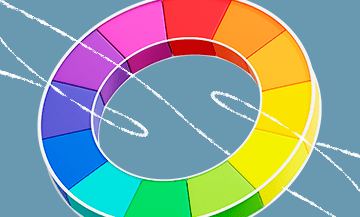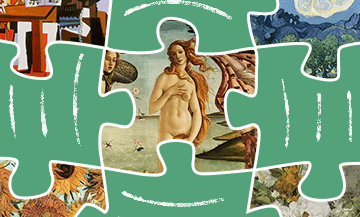What qualities does painting and drawing develop in a person?
Painting and drawing are art forms capable of transforming everyday routine into a fascinating world of colors and shapes. They not only reveal talents and creative abilities but also develop a range of valuable qualities in a person.
By picking up a brush or pencil, an artist opens up an unlimited world of possibilities. They create their own world, filling it with ideas, emotions, and fantasies. A person learns to think creatively, see beauty in small things, and express their feelings on canvas or paper.
The benefits of drawing for people: adults, the elderly and pregnant women
Drawing for adults.
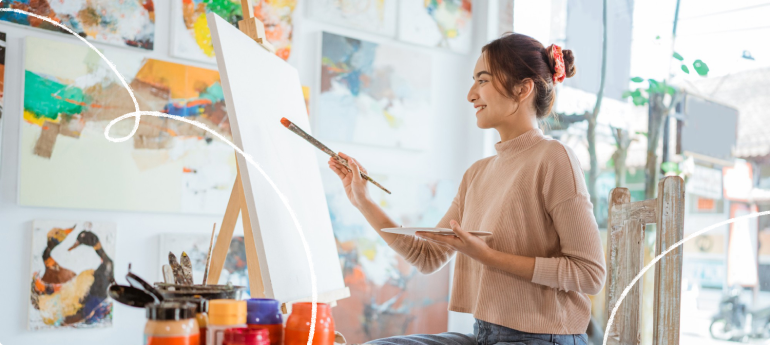
- Relaxation and Stress Resilience
For many adults, the modern world has become a source of stress and anxiety. Drawing is an excellent means of relaxation, helping to cope with everyday troubles. When you draw, you forget about your problems, immerse yourself in the moment, and relax your mind. - Development of Creative Thinking
You develop creative thinking and imagination. Choosing colors, composition, and style allows you to expand your artistic taste. Additionally, your analytical skills and ability to solve creative problems improve. - Improvement of Coordination and Motor Skills
Drawing requires excellent hand-eye coordination. Such skills will be useful in everyday life and even in professional activities.
Drawing for the elderly
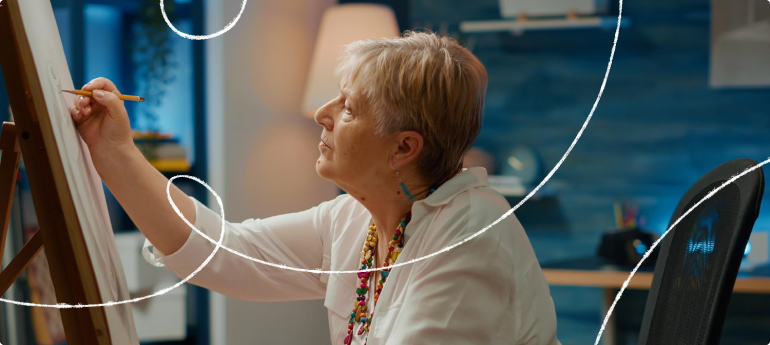
- Preservation of Cognitive Abilities
Drawing supports the cognitive abilities of the elderly. It can strengthen memory, concentration, and mental flexibility. Constant learning and practicing new skills contribute to slowing brain aging. - Social Activity
Group drawing classes are a social activity that helps establish connections with others. Simply put, for the elderly, it’s an opportunity to not stay at home but to meet new people, enjoy communication with like-minded individuals, and relish life and peace. - Self-Expression and Self-Assertion
By drawing, the elderly express their feelings and stories. This helps them better understand themselves and their world. - Fulfilling Childhood Dreams
Fulfilling long-held dreams and plans brings indescribable joy and relief from worries. It’s especially wonderful when we realize our creative potential, as it allows us to reveal ourselves from a new perspective and enjoy the process. Creativity fills us with joy, leaving little room for anxious thoughts and sadness.
Drawing for pregnant women
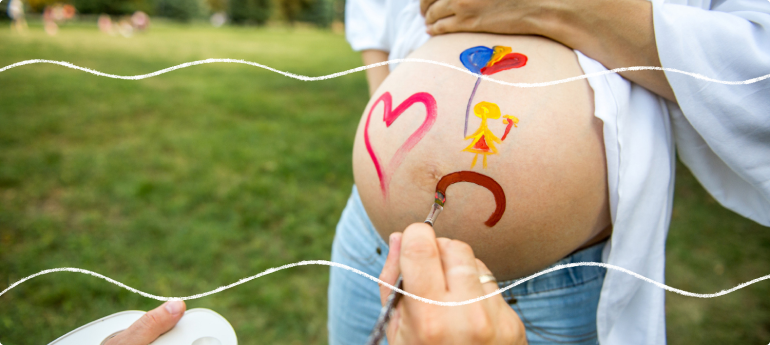
- Reducing Stress and Anxiety
Pregnancy is a period of increased anxiety and stress. Drawing calms the mind, which positively affects the physical and emotional state of the expectant mother. - Bonding with the Baby
Did you know that by drawing, you are communicating with your baby even before birth? Many expectant mothers create drawings to convey their love and care to their baby. - Preparation for Childbirth
Drawing helps pregnant women visualize and positively prepare for the upcoming birth. It contributes to strengthening psychological readiness for this important event.
Drawing as a way to deal with stress and work with emotions
Drawing is not just a hobby or art, it is magic that allows us to dive into the world of our own emotions and remove the invisible shackles of stress.
You take a brush in your hand and begin to breathe life into an empty canvas, turning it into a vast tapestry of feelings and experiences.
Drawing is a conversation without words, the language of the soul, a way to meet yourself on paper. It is a moment when every stroke, every color, every line becomes a reflection of your deepest thoughts. It allows us to express what cannot be conveyed with words.
It is a moment of complete concentration when everything else disappears, and only what you want to express comes to the forefront. Through the strokes of paint and lines of the drawing, you can see an entire story. This story encompasses your joys and sorrows, dreams and fears, moments of happiness and melancholy.
Repetitive movements in drawing, such as coloring large areas or creating monotonous lines, create a meditative effect, promoting relaxation and focus on the moment.
Moreover, while drawing, endorphins—hormones of happiness—are released, improving mood. Finishing a picture and observing the result of your efforts, it is impossible not to rejoice in your success.
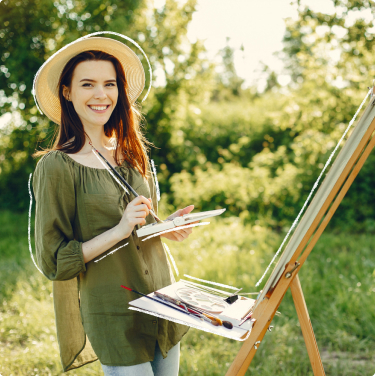

Drawing as a hobby
Pursuing a hobby is an essential element in everyone’s life. A hobby not only gives us the ability to express our individuality but also fosters the development of creative thinking.
This is especially valuable in our hectic times when many of us are tied to desks surrounded by monitors and endless spreadsheets of numbers. In such moments, the art of drawing can become our reliable companion, bringing joy and harmony.
Psychologists agree that drawing has an amazing ability to balance our emotional state and improve our mental well-being. It allows us to immerse ourselves in the world of colors and shapes, forget about daily worries, and simply enjoy the moment.
But how do you find the style and type of drawing that suits you best?
Some may fall in love with painting, where the variety of colors and textures open up endless possibilities. Others may find that graphic art, where black and white lines dance on paper creating amazing compositions, is more to their liking.
Be patient and explore yourself, try different creative styles, and you will surely find something that speaks to you.
Drawing as a way to train memory and attention
Memory, like the path of art, sometimes seems mysterious. But drawing gives you the opportunity to literally feel your memories on the canvas. By choosing colors, textures, and lines, you recreate past moments, like a magician summoning memories from the depths of your mind.
When drawing, we observe carefully, recalling every detail to convey it on the canvas. This process requires deep concentration and, surprisingly, brings an additional bonus of improving our memory.
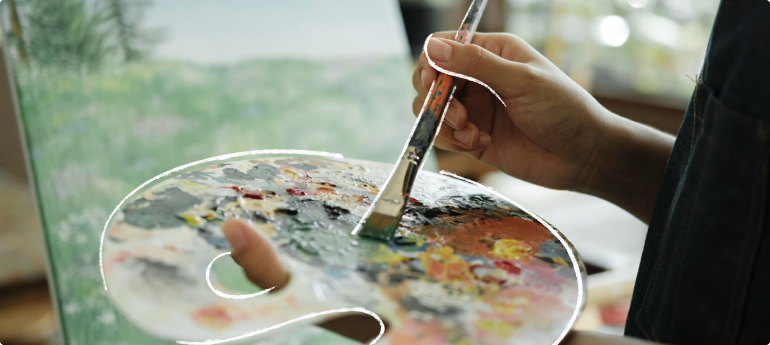
Drawing allows us to organize the chaos around us into clear images, and this process stimulates the mind, enriching our ability to retain information in memory and retrieve it as needed.
Ultimately, drawing becomes not only an art but also a useful exercise for the mind, enhancing our ability not only to remember but also to bring information into reality.
Drawing is the development of creative abilities
Drawing also promotes the development of creative abilities. It teaches us to see the world in new colors, shapes, and perspectives, enhancing our capacity for analysis and interpretation of the surrounding reality. We become different individuals—deeper and more thoughtful.
Through drawing, our physical and mental development gains new dimensions, making us more attentive, logical, and unconventional.
Drawing is also a source of inspiration and delight, liberating our creativity from constraints. In the world of art, there are no words like “can’t” or “impossible”—here, you can draw as you wish.
Think of drawing as a journey in which you will gain unforgettable emotions and deepen your understanding of the world around you, enrich your views on objects, and learn to use them more consciously.
Drawing will teach you to think about the concept of a piece, choose artistic styles, create images, and achieve set goals.
33 reasons to take up painting
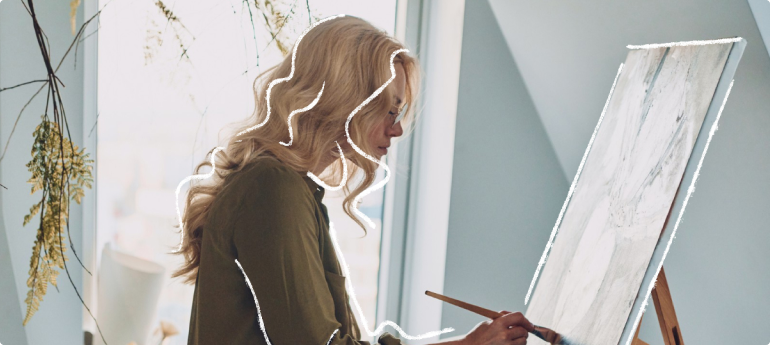
For those who need more reasons after reading the article:
- Painting is a way to express your feelings, ideas, and opinions without words.
- Drawing helps you relax and forget about everyday worries.
- Painting helps you find your uniqueness and style.
- To succeed in painting (and in life in general), persistence and self-discipline are required.
- Your self-esteem will improve. You will realize that you can develop your drawing talent.
- Creating a piece of art is akin to a meditative state.
- Painting fosters creative thinking and the ability to find unconventional solutions.
- The art of other artists inspires and motivates.
- Painting is part of humanity’s cultural heritage. Contribute something of your own to the world of visual art.
- Painting allows you to study and experiment with colors.
- Working with a brush develops hand motor skills.
- In drawing classes, you will make new friends and interact with other interesting people

- You will no longer have the question of “what to do.”
- Painting teaches you to finish what you start.
- Psychologists believe that engaging in painting helps reduce stress and improve mental health.
- You can create unique gifts for loved ones and friends—paintings.
- You will always have something to talk about regarding your creativity, becoming a more educated and versatile person.
- You can master a new profession—illustrator, designer, architect.
- Drawing stimulates the work of both the right and left hemispheres of the brain.
- You can enjoy sketching during long trips.
- You will better understand yourself and your inner world.
- Painting inspires an interest in art in general.
- Your art can also inspire and support others.
- Painting helps you understand the history and culture of different eras.
- Additional income.
- The possibility to decorate your home with new paintings at any moment.
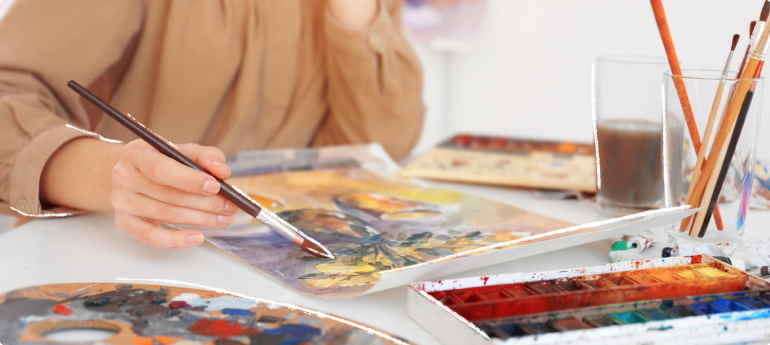
- Your unusual habits and worldview can be portrayed as a creative, unconventional character. After all, all artists are somewhat unconventional individuals.
- The public is very interested in artists.
- Drawing positively affects vision. You constantly train your eyes by shifting focus from the canvas to the subject being depicted.
- You can become a well-known and popular artist.
- By drawing, you better understand your values and beliefs.
- If your child asks you to draw something for school, you can finally show off your talents and skills—after all, you have learned to draw.
- Positive emotions. A sea of positive emotions from drawing!
Conclusion
Drawing can transform our reality, opening up endless possibilities for self-expression and creativity. I hope that drawing will bring you a lot of joy in your life.
Question-answer
Drawing lessons are not just sessions where you dream of becoming the next Van Gogh. You will also discover your inner world and acquire many valuable skills.
- Drawing is a wonderful way to express your feelings, thoughts, and ideas that are sometimes difficult to convey with words. You will create unique works and share them with the world.
- You will learn to focus and relax.
- You will start noticing unique details and shapes around you.
- Regular practice in drawing helps improve hand motor skills.
- You will get used to drawing well at any moment in life—even when there is no inspiration.
- Success in drawing will boost your confidence and self-esteem.
- With your favorite hobby, your life will take on new colors.
Psychologists and researchers claim that the process of drawing contributes to harmony between the body and mind. It allows a person to focus, forget about everyday concerns, and immerse themselves in a world of creative ideas. Drawing stimulates the right hemisphere of the brain, which is responsible for intuition, imagination, and emotions. As a result, we begin to see the world in a new light, with brighter colors and deeper meanings.
When we draw, we express our feelings and emotions on the canvas. This provides an opportunity to release stress, anxious thoughts, and negative emotions.
It is also worth mentioning that drawing promotes the development of creative thinking and imagination. It teaches us to see the world from different perspectives, find unconventional solutions, and develop entirely unique ideas.
Firstly, drawing allows you to forget about annoying worries and delve into a world of inner inspiration. When you pick up a brush and start creating, you open up a vast field for self-expression.
Secondly, you will expand your view of the world, finding beauty and inspiration in everyday things. You will start to notice details that previously eluded you and enrich your development with new images.
Finally, drawing is a wonderful way to connect with others. You can draw together with friends or family, share ideas, and inspire each other. Your relationships with the world around you will become more interesting.
Drawing is an art that can bring joy and satisfaction, and it is not limited to just art studios and museums. Your home is your personal palette, and can you draw at home? Definitely, yes!
Choose a cozy spot in your home where you will feel comfortable and inspired to create. It could be a desk by the window, a small corner in the garden, or even a room that you set up as an art studio.
Don’t be afraid to experiment and draw what inspires you. Draw nature, abstraction, portraits, or something completely unique. Your home is your creative playground, and you can create however you like.
Drawing with both hands is not only an engaging activity but also a unique way to develop your brain, coordination, and creative abilities. This unusual practice can bring many amazing benefits to your life.
Drawing with both hands activates both hemispheres of the brain simultaneously. It requires concentration, attention to detail, and harmony of movements. This process stimulates neural activity, strengthening the connections between the left and right hemispheres. As a result, you can become more creative and analytical, as well as improve your problem-solving abilities.
Constant practice of drawing with both hands will enhance hand-eye coordination, which is beneficial not only for drawing but also in everyday life. Your motor skills will become more precise and confident, which is very useful even in ordinary tasks.
Drawing requires attention to detail, concentration, and imagination. In this process, our brain is forced to work, creating connections between visual, motor, and emotional domains. Thus, drawing stimulates neuroplasticity—the brain’s ability to change its structure and functions.
Research shows that drawing can improve our ability to remember information. This happens due to the activation of visual memory, which allows us to recall details and images.
When we depict something on paper, we are essentially creating our own “image” of this information in our brain. This helps us better retain facts, ideas, and even events.
Moreover, drawing can enhance our analytical and critical thinking abilities. It teaches us to see things from different perspectives and find unconventional solutions to complex problems.
When you draw, you often express your ideas and concepts through images and symbols. This process contributes to a deeper understanding of what you want to convey. Visual representation can help you better structure your thoughts, which, in turn, enriches your speech.
Additionally, you convey your feelings through drawing and also learn to express emotions more effectively with words. Your vocabulary expands, and your speech becomes more emotional and evocative.
The more you experiment with different arts and ways of expression, the richer and more diverse your thoughts and words become.
Artists have highly developed brain regions — the visual cortex and the frontal lobes. The visual cortex is responsible for processing visual information, while the frontal lobes are involved in creative thinking and planning.
The unique ability of artists to see details that might escape ordinary observation is often associated with higher activity in the visual cortex. Artists can notice nuances in color, texture, shape, and lighting, which allows them to reproduce the world in their work with incredible precision and expressiveness.
The frontal lobes, in turn, play a key role in the creative process. They help artists formulate ideas, plan compositions, and choose their working style.
Drawing requires the activation of various mental processes, such as imagination, attention to detail, and solving creative problems. This helps maintain mental activity and can aid in combating issues related to cognitive aging.
The art of drawing releases endorphins, hormones of joy, and reduces stress. It is very important for elderly individuals to take care of their psychological well-being.
Drawing fosters the development of your creativity, allowing you to bring visual ideas to life. You learn to notice the subtle nuances in the surrounding world, which is useful not only in art but also in everyday life.
Your hand motor skills and coordination improve, a skill beneficial for both children and adults.
Once you start drawing, you’ll find yourself interested in other areas of art as well, becoming a person who is interesting to engage with.
Drawing enriches our lives by providing us with a means of creative self-expression. It is a way of communicating with the world and with ourselves, allowing us to bring our ideas and vision to life on the canvas. Through drawing, we can share our dreams, passions, stories, and even our struggles with life’s challenges with those around us.
As we practice drawing, we begin to notice shadows, reflections, textures, and colors around us, which adds depth and variety to our lives.
And, of course, the therapeutic effect. During the creative process, the world disappears, and only what is before you on the canvas matters.
Drawing can become a part of our lives and open doors to a world full of beauty and inspiration.



